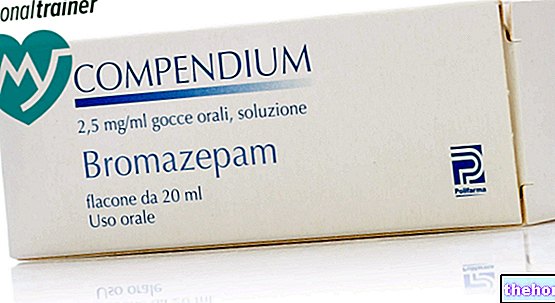Active ingredients: Levodropropizina
Levotuss 60 mg tablets
Levotuss package inserts are available for pack sizes:- Levotuss 60 mg tablets
- Levotuss 30 mg / 5 ml syrup
Why is Levotuss used? What is it for?
WHAT IS IT
Levotuss 60 mg tablets belongs to the category of cough suppressants.
WHY IT IS USED
Levotuss 60 mg tablets are used for the symptomatic treatment of cough.
Contraindications When Levotuss should not be used
The product should not be administered in patients with hypersensitivity to the active substance or to any of the excipients. Administration of the drug should be avoided in patients with bronchial hypersecretion and reduced mucociliary function (Kartagener's syndrome, ciliary dyskinesia).
Do not administer in known or suspected pregnancy and during lactation: (see What to do during pregnancy and lactation).
Precautions for use What you need to know before taking Levotuss
It is recommended to use with caution in patients with severe renal insufficiency (creatinine clearance below 35 ml / min).
In light of the evidence that sensitivity to various drugs is altered in the elderly, special caution should be used when levodropropizin is administered to elderly patients.
Caution is also advised in case of concomitant intake of sedative drugs in particularly sensitive individuals (see Which medicines or foods can modify the effect of the medicine).
Interactions Which drugs or foods can modify the effect of Levotuss
Animal pharmacology studies have shown that levodropropizine does not potentiate the effect of active substances on the central nervous system (eg benzodiazepines, alcohol, phenytoin, imipramine). In animals, levodropropizine does not modify the activity of oral anticoagulants, such as warfarin and nor does it interfere with the hypoglycemic action of insulin. In clinical pharmacology studies, the association with benzodiazepine does not modify the EEG picture. However, caution should be exercised in case of concomitant use of sedative drugs in particularly sensitive individuals (see Precautions for use).
Clinical studies show no interaction with drugs used in the treatment of bronchopulmonary diseases such as ß2 agonists, methylxanthines and derivatives, corticosteroids, antibiotics, mucoregulators and antihistamines.
If you are using other medicines ask your doctor or pharmacist for advice.
Warnings It is important to know that:
Antitussive drugs are symptomatic and should only be used pending diagnosis of the underlying cause and / or therapy effect of the underlying disease.
Therefore do not use for prolonged treatments. After a short period of treatment without appreciable results, consult your doctor.
Since the active ingredient in animals overcomes the placental barrier and is present in breast milk, the use of the drug is contraindicated in women who are presumed or confirmed pregnant and during breastfeeding.
What to do during pregnancy and breastfeeding
Levotuss 60 mg tablets should not be used during pregnancy and breastfeeding. Use should also be avoided if you suspect pregnancy or plan to maternity leave.
Driving and using machines
No studies on the ability to drive and / or use machines have been performed. However, as the product may, although rarely, cause drowsiness (see Undesirable Effects), the patient should use caution when intending to drive or operate machinery.
Important information about some of the ingredients
Lactose
This medicinal product contains lactose: if you have been told by your doctor that you have an intolerance to some sugars, contact your doctor before taking this medicinal product.
Dosage and method of use How to use Levotuss: Dosage
How many
Warning: do not exceed the indicated doses without medical advice
Adults and children over 30 kg: one tablet
When and for how long
Up to 3 times a day at intervals of at least 6 hours. In the absence of information on the effect of food on absorption, it is advisable to take the drug between meals.
Treatment should be continued until the cough subsides. However, if after 2 weeks of therapy the cough is still present, it is advisable to stop the treatment and ask your doctor for advice. In fact, cough is a symptom and the causative pathology should be studied and treated.
Like
To release a tablet it is necessary to press on the blister from the plastic part.
It is preferable to take the product on an empty stomach.
Do not exceed the recommended dose.
Overdose What to do if you have taken too much Levotuss
In case of accidental ingestion / intake of an excessive dose of Levotuss 60 mg tablets, notify your doctor immediately or go to the nearest hospital.
Side Effects What are the side effects of Levotuss
Like all medicines, Levotuss can cause side effects, although not everybody gets them.
Palpitations, tachycardia, nausea, vomiting, diarrhea, erythema may occur during treatment with levodropropizin. Reactions reported as serious are urticaria and anaphylactic reaction.
Most of the reactions that occur following levodropropizin are non-serious and the symptoms have resolved with discontinuation of therapy and, in some cases, with specific pharmacological treatment.
The reported adverse reactions (incidence unknown) are as follows:
Eye disorders
Mydriasis, bilateral blindness.
Disorders of the immune system
Allergic and anaphylactoid reactions, eyelid edema, angioneurotic edema, urticaria.
Psychiatric disorders
Nervousness, sleepiness, personality change or personality disorder.
Nervous system disorders
Syncope, dizziness, vertigo, tremors, paraesthesia, tonic-clonic convulsion and attack of petit mal, hypoglycemic coma.
Cardiac pathologies
Palpitations, tachycardia, atrial bigeminy.
Vascular pathologies
Hypotension.
Respiratory, thoracic and mediastinal disorders
Dyspnea, cough, respiratory tract edema.
Gastrointestinal disorders
Gastric pain, abdominal pain, nausea, vomiting, diarrhea.
Hepatobiliary disorders
Cholestatic hepatitis.
Skin and subcutaneous tissue disorders
Urticaria, erythema, rash, pruritus, angioedema, skin reactions, glossitis and aphthous stomatitis Epidermolysis.
Musculoskeletal and connective tissue disorders
Weakness of the lower limbs.
General disorders and administration site conditions
General malaise, generalized edema, asthenia.
Pediatric population
A case of somnolence, hypotonia and vomiting has been reported in a newborn after the nursing mother took levodropropizin. Symptoms appeared after the feed and resolved spontaneously by suspending breastfeeding for a few feedings.
Compliance with the instructions contained in the package leaflet reduces the risk of undesirable effects.
If any of the side effects gets serious, or if you notice any side effects not listed in this leaflet, please inform your doctor or pharmacist.
Expiry and Retention
Expiry: see the expiry date indicated on the package
Warning: do not use the medicine after the expiry date indicated on the package.
No special storage precautions.
Keep this medicine out of the reach and sight of children.
It is important to always have the information about the medicine available, so keep both the box and the package leaflet.
Medicines should not be disposed of via wastewater or household waste. Ask your pharmacist how to throw away medicines you no longer use. This will help protect the environment.
Composition and pharmaceutical form
COMPOSITION
Each tablet contains:
Active ingredient: levodropropizina 60 mg
Excipients: lactose monohydrate, microcrystalline cellulose, sodium starch glycolate, magnesium stearate
HOW IT LOOKS
Levotuss 60 mg tablets come in tablet form for oral use. The contents of the pack are 10 or 20 tablets
Source Package Leaflet: AIFA (Italian Medicines Agency). Content published in January 2016. The information present may not be up-to-date.
To have access to the most up-to-date version, it is advisable to access the AIFA (Italian Medicines Agency) website. Disclaimer and useful information.
01.0 NAME OF THE MEDICINAL PRODUCT
LEVOTUSS 60 MG TABLETS
02.0 QUALITATIVE AND QUANTITATIVE COMPOSITION
Each tablet contains
Active ingredient: levodropropizina 60 mg.
Excipients: lactose. Each tablet contains 89.37 mg of lactose monohydrate corresponding to 84.91 mg of anhydrous lactose.
For the full list of excipients, see section 6.1.
03.0 PHARMACEUTICAL FORM
Tablet.
04.0 CLINICAL INFORMATION
04.1 Therapeutic indications
Symptomatic cough therapy.
04.2 Posology and method of administration
Adults and children over 30 kg: one tablet up to 3 times a day at intervals of at least 6 hours.
Treatment should be continued until the cough subsides or as directed by the doctor. However, if the cough is still present after 2 weeks of therapy, it is advisable to stop the treatment and ask your doctor for advice. In fact, cough is a symptom and the causative pathology should be studied and treated.
04.3 Contraindications
Hypersensitivity to the active substance or to any of the excipients. The administration of the drug should be avoided in patients with bronchorrhea and with reduced mucociliary function (Kartagener's syndrome, ciliary dyskinesia).
Pregnancy and lactation (see section 4.6).
04.4 Special warnings and appropriate precautions for use
The observation that the pharmacokinetic profiles of levodropropizin are not markedly altered in the elderly suggests that dose adjustments or modification of the dosing intervals may not be required in the elderly. However, in light of the evidence that sensitivity to various drugs is altered in the elderly, special caution should be used when levodropropizin is administered to elderly patients.
Caution is advised in patients with severe renal insufficiency (creatinine clearance below 35 ml / min).
It is advisable to use caution even in case of concomitant intake of sedative drugs in particularly sensitive individuals (see section 4.5).
This medicine contains lactose: Patients with rare hereditary problems of galactose intolerance, the Lapp lactase deficiency, or glucose-galactose malabsorption should not take this medicine.
Antitussive drugs are symptomatic and should only be used pending diagnosis of the underlying cause and / or therapy effect of the underlying disease.
In the absence of information on the effect of food intake on drug absorption, it is advisable to take the drug between meals.
04.5 Interactions with other medicinal products and other forms of interaction
Animal pharmacology studies have shown that levodropropizine does not potentiate the pharmacological effect of active substances on the central nervous system (eg benzodiazepines, alcohol, phenytoin, imipramine). In animals, the product does not modify the activity of oral anticoagulants, such as warfarin nor does it interfere with the hypoglycemic action of insulin. In human pharmacology studies, the combination with benzodiazepine does not modify the EEG picture. However, caution should be exercised in case of concomitant administration of sedative drugs in particularly sensitive individuals (see section 4.4).
Clinical studies show no interaction with drugs used in the treatment of bronchopulmonary diseases such as β2-agonists, methylxanthines and derivatives, corticosteroids, antibiotics, mucoregulators and antihistamines.
04.6 Pregnancy and lactation
Studies of teratogenesis, reproduction and fertility as well as peri and postnatal studies did not reveal specific toxic effects.
However, since a slight delay in weight gain and growth was observed in animal toxicology studies at the dose of 24 mg / kg and since levodropropizin is able to overcome the placental barrier in the rat, the use of the drug it is contraindicated in women who intend to become or are already pregnant as its safe use is not documented (see section 4.3). Studies in rats indicate that the drug is found in breast milk for up to 8 hours after administration. Therefore, the use of the drug during lactation is contraindicated.
04.7 Effects on ability to drive and use machines
No studies on the ability to drive and / or use machines have been performed.
However, since the product may, although rarely, cause drowsiness (see section 4.8), use with caution in those patients who intend to drive vehicles or operate machinery, informing them of this possibility.
04.8 Undesirable effects
Palpitations, tachycardia, nausea, vomiting, diarrhea, erythema may occur during treatment with levodropropizin. Reactions reported as serious are urticaria and anaphylactic reaction.
Most of the reactions that occur following levodropropizin are non-serious and the symptoms have resolved with discontinuation of therapy and, in some cases, with specific pharmacological treatment.
The reported adverse reactions (incidence unknown) are as follows:
Eye disorders
Mydriasis, bilateral blindness.
Disorders of the immune system
Allergic and anaphylactoid reactions, eyelid edema, angioneurotic edema, urticaria.
Psychiatric disorders
Nervousness, sleepiness, personality change or personality disorder.
Nervous system disorders
Syncope, dizziness, vertigo, tremors, paraesthesia, tonic-clonic convulsion and attack of petit mal, hypoglycemic coma.
Cardiac pathologies
Palpitations, tachycardia, atrial bigeminy.
Vascular pathologies
Hypotension.
Respiratory, thoracic and mediastinal disorders
Dyspnea, cough, respiratory tract edema.
Gastrointestinal disorders
Gastric pain, abdominal pain, nausea, vomiting, diarrhea.
Hepatobiliary disorders
Cholestatic hepatitis.
Skin and subcutaneous tissue disorders
Urticaria, erythema, rash, pruritus, angioedema, skin reactions, glossitis and aphthous stomatitis. Epidermolysis.
Musculoskeletal and connective tissue disorders
Weakness of the lower limbs.
General disorders and administration site conditions
General malaise, generalized edema, asthenia.
One case of loss of consciousness has been reported, which resolved completely the day after the onset of the reaction. The patient was taking other medications at the time of the reaction.
Pediatric population
A case of somnolence, hypotonia and vomiting has been reported in a newborn after the nursing mother took levodropropizin. Symptoms appeared after the feed and resolved spontaneously by suspending breastfeeding for a few feedings.
04.9 Overdose
No significant undesirable effects were reported after drug administration up to 240 mg single administration and up to 120 mg t.i.d. for 8 consecutive days. There are known cases of overdose in children aged 2 to 4 years.These are cases of accidental overdose all resolved without consequences. In most cases, the patients experienced abdominal pain and vomiting and in one case, after taking 600 mg of levodropropizin, the patient experienced excessive sleep and decreased oxygen saturation. In case of overdose with evident clinical manifestations, immediately institute symptomatic therapy and apply the usual emergency measures (gastric lavage, activated charcoal meal, parenteral administration of liquid, etc.), if necessary.
05.0 PHARMACOLOGICAL PROPERTIES
05.1 Pharmacodynamic properties
Pharmacotherapeutic group: preparations for cough and colds; Cough suppressants.
ATC: R05DB27.
Levodropropizin is a molecule obtained by stereospecific synthesis and chemically corresponds to S (-) 3- (4-phenyl-piperazin-1-yl) -propan-1,2-diol.
It is a drug with antitussive activity, mainly of the peripheral type at the tracheobronchial level, associated with antiallergic and antibronchospastic activity; moreover it exerts, in the animal, a local anesthetic action.
In the animal, the antitussive activity of levodropropizin after oral administration was equal to or superior to dropropizine and cloperastine on cough induced by peripheral stimuli such as chemicals, mechanical stimulation of the trachea and electrical stimulation of the vagal afferent. Its activity on cough induced by central stimulus such as the electrical stimulation of the trachea in the guinea pig is about 10 times lower than that of codeine while the power ratio between the two drugs is between 0.5 and 2 in peripheral stimulation tests such as those for citric acid, ammonium hydrate and sulfuric acid.
Levodropropizin is not active when administered intracerebroventricularly in the animal. This fact suggests that the antitussive activity of the compound is due to a peripheral mechanism and not to action on the central nervous system. The comparison between the efficacy of levodropropizine and that of codeine, administered orally and aerosol, in preventing experimentally induced cough in the guinea pig, further confirms the peripheral site of action of levodropropizin; in fact, levodropropizine is equivocal or more potent than codeine for aerosol administration while, when administered orally, it is 2 times less potent than codeine.
Regarding the mechanism of action, levodropropizine performs its antitussive effect through an inhibitory action at the level of the C fibers. anesthetized cat, markedly reduces the activation of C fibers and abolishes associated reflexes.
Levodropropizine is significantly less active than dropropizine on oxotremorin-induced tremors and pentamethylenetetrazole-induced seizures and in modifying spontaneous motility in mice.
Levodropropizine does not displace naloxone from the opioid receptors in the rat brain; it does not modify the morphine withdrawal syndrome and the interruption of its administration is not followed by the appearance of addictive behaviors.
Levodropropizina does not cause in the animal neither depression of the respiratory function nor appreciable cardiovascular effects, moreover it does not induce constipating effects.
Levodropropizin acts on the bronchopulmonary system by inhibiting the bronchospasm induced by histamine, serotonin and bradykinin. The drug does not inhibit acetylcholine-induced bronchospasm thus demonstrating the absence of anticholinergic effects. In the animal the ED50 of the anti-bronchospastic activity is comparable to that of the antitussive activity.
In healthy volunteers, a dose of 60 mg of the drug reduces cough induced by citric acid aerosols for at least 6 hours.
Numerous experimental evidences demonstrate the clinical efficacy of levodropropizin in reducing cough of various etiologies including cough associated with bronchopulmonary carcinoma, cough associated with upper and lower respiratory tract infections and whooping cough. The antitussive action is generally comparable to that one. of centrally acting drugs with respect to which levodropropizin demonstrates a better tolerability profile, especially as regards the central sedative effects.
At therapeutic doses, levodropropizine did not modify the EEG trace and psychomotor capacity in humans. There were no changes in cardiovascular parameters in healthy volunteers treated up to a dose of 240 mg of levodropropizine.
This drug does not depress neither respiratory function nor mucociliary clearance in humans. In particular, a recent study has shown that levodropropizine is devoid of depressive effects on the central breathing regulation systems in patients with chronic respiratory insufficiency, both in conditions of spontaneous breathing and during hypercapnic ventilation.
05.2 Pharmacokinetic properties
Pharmacokinetic studies were conducted in rats, dogs and humans.
Absorption, distribution, metabolism and excretion were very similar in the three species considered, with an oral bioavailability greater than 75%. The recovery of radioactivity after oral administration of the product was 93%.
Binding to human plasma proteins is negligible (11-14%) and comparable to that observed in dogs and rats.
Levodropropizin is rapidly absorbed in humans after oral administration and is rapidly distributed throughout the body. The half-life is approximately 1-2 hours. The product is mainly excreted in the urine as unaltered product and its metabolites (conjugated levodropropizin and free and conjugated p-hydroxy levodropropizin). In 48 hours the urinary excretion of the product and the aforementioned metabolites is equal to about 35% of the administered dose. Repeated administration tests show that an 8-day treatment (tid) does not alter the absorption and elimination profile of the drug. thus allowing to exclude accumulation and metabolic self-induction phenomena.
There are no significant changes in the pharmacokinetic profile in children, the elderly and patients with mild or moderate renal impairment.
05.3 Preclinical safety data
The acute oral toxicity is 886.5 mg / kg, 1287 mg / kg and 2492 mg / kg in rats, mice and guinea pigs, respectively. The therapeutic index in the guinea pig, calculated as the LD50 / DE50 ratio after oral administration is between 16 and 53 depending on the experimental model of cough induction. Toxicity tests for repeated oral administration (4-26 weeks) showed that the dose without toxic effects is 24 mg / kg / day.
06.0 PHARMACEUTICAL INFORMATION
06.1 Excipients
Lactose monohydrate, microcrystalline cellulose, sodium starch glycolate, magnesium stearate.
06.2 Incompatibility
Not relevant.
06.3 Period of validity
24 months.
The period of validity is intended under normal storage conditions.
06.4 Special precautions for storage
No special storage precautions.
06.5 Nature of the immediate packaging and contents of the package
White PVC / Alu blister contained in a cardboard box. Pack of 10 or 20 tablets.
06.6 Instructions for use and handling
To release a tablet it is necessary to press on the blister from the plastic part.
07.0 MARKETING AUTHORIZATION HOLDER
Dompé pharmaceuticals s.p.a. - Via San Martino 12 - Milan
dealership for sale: Dompé spa - L "Aquila
08.0 MARKETING AUTHORIZATION NUMBER
AIC n. 026752055 - "60 mg tablets" 10 tablets;
AIC n. 026752067 - "60 mg tablets" 20 tablets
09.0 DATE OF FIRST AUTHORIZATION OR RENEWAL OF THE AUTHORIZATION
Date of first authorization: AIFA determination of November 2011
10.0 DATE OF REVISION OF THE TEXT
July 2012




























